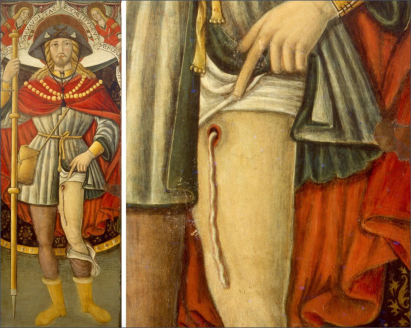6 July 2018
Holy worms: Historical depictions of Guinea Worm disease in Medieval art
Posted by Shane Hanlon
This is part of a series of posts from our own Shane Hanlon’s disease ecology class that he’s currently teaching at the University of Pittsburgh Pymatuning Laboratory of Ecology. Students were asked to write popular science posts about (mostly) wildlife diseases. Check out all the posts here.
By Mackenzie Rogers

In a medieval painting, a possible Guinea worm can be seen creeping out of the leg of St. Roch, a 14th-century French pilgrim. Credit: Raffaele Gaeta
This 15th-century altarpiece depicts St. Roch, a Catholic saint from the 14th century known for his work with plague victims. The prominent feature in this, and almost all depictions of St. Roch is the wound/mark on his upper thigh. It has been speculated to be a birthmark, a boil, or a sore and until recently, art historians said this particular piece shows a long drop of pus leaking from a wound. Now, researchers believe this actually depicts Guinea worm disease (GWD).
Guinea worm disease (Dracunculiasis) is an infection caused by the parasitic nematode worm, Dracunculus medinensis. The female parasite lays eggs in ponds or other stagnant bodies of water. Tiny copepods (water fleas) eat the Guinea worm larvae. When a human drinks the contaminated water and ingests the copepods, Guinea worm larvae are released in the stomach of the human and begin to grow for the next year until it’s about 2 to 3 feet long and as wide as a spaghetti noodle. People usually don’t have any symptoms during the growth year.
Sources:
- https://www.cdc.gov/parasites/guineaworm/gen_info/faqs.html
- https://www.amnh.org/explore/science-topics/disease-and-eradication/countdown-to-zero/guinea-worm
- https://www.britannica.com/science/guinea-worm-disease
- https://www.livescience.com/58298-earliest-depiction-of-guinea-worm-medieval-painting.html
- https://www.cartercenter.org/health/guinea_worm/
- https://en.wikipedia.org/wiki/Saint_Roch


 The Plainspoken Scientist is the science communication blog of AGU’s Sharing Science program. With this blog, we wish to showcase creative and effective science communication via multiple mediums and modes.
The Plainspoken Scientist is the science communication blog of AGU’s Sharing Science program. With this blog, we wish to showcase creative and effective science communication via multiple mediums and modes.